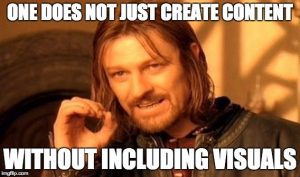In just the past year, we’ve seen some big changes to the popular social media channels that we know and love. Facebook came out with Facebook live, and more recently, Facebook stories. Twitter recently launched a live video feature, Instagram came out with live video and IG stories, and Snapchat came out with lens filters, stickers, and memories. Are you starting to notice a pattern here? It’s all about the visuals.
And for good reason, too. Humans are visual creatures. We’re incredibly better at remembering pictures than we are at remembering text. This is partially because reading is so inefficient for us. Our brain sees words as a lot of tiny pictures, and it takes time for our brain to read those words and then process them into images we can understand.
But when we see images, we process them so much faster. In fact, according to a study by Brain Rules, when people hear information, they’re likely to remember only 10% of that information three days later. But if a relevant image is paired with that same information, people retained 65% of the information three days later. So the phrase “a picture is worth a thousand words” is really not some kitschy, cliche phrase— it’s the truth. The fact is that we simply process images faster and more efficiently than we do text.
Source: Mammoth Infographics
So if you haven’t started using visuals in your marketing strategy yet, it’s time to evolve with the times. Last year, 37% of marketers said visual marketing was the most important form of content for their business, second only to blogging at 38% (Social Media Examiner, 2016). The hard truth is that if you aren’t using visuals in your marketing, you’re losing.
So here are some different visuals you can incorporate into your strategy, and how to best use them:
Images
When writing a piece for your blog or some other form of content, splitting up the body of text with some relevant images is a good way to keep people engaged with what you’ve written. In fact, articles with images get 94% more views than those without, according to marketer Jeff Bullas. Keep in mind that people’s attention spans are shorter than ever and text-heavy content is more difficult to get through.
Images are also important to use on your social channels. Studies show that Facebook posts with images see 2.3 times more engagement than those without images (BuzzSumo, 2015) and tweets with images receive 150% more retweets than tweets without images (Buffer, 2016). Regardless of the social platforms you use, make sure you’re including relevant images on any posts you make.
You can get creative with your images too. These don’t just have to be your classic photo taken by an iPhone (although those work just fine). They can be memes, which are just images paired with humorous captions and widely embraced by Millennials. And it’s easy with tools like Meme Generator. 

Or they can even be screenshots. Often, screenshots are a good way of visually explaining how something works— be that your product or service, how to sign up for something, etc. It also builds trust between you and the viewer. It makes them feel like they’re sitting right there with you looking at your computer screen and the internal workings of your business. You can even draw on screenshots and point out specific things in the image. Awesome Screenshot is a handy tool for this.
For the sake of not infringing on copyrights, but also to add your own branded touch, it’s best to use your own original images. There are tools out there like Canva which allow you to easily create unique and engaging images for free. You can also use good quality photos for free from photo-sharing sites like Flickr. But if you do use someone else’s image, be sure to credit them with the rights to the image.
Video
Videos are steadily on the rise for the most effective form of marketing. By the year 2020, video marketing will make up 79% of global internet traffic (Tubular Insights, 2017). Videos are altogether more engaging, entertaining, and captivating to viewers.
And there are plenty of different types of videos you can create to amplify your brand voice and add extra value to your marketing:
- Tutorial videos – 4x as many consumers would prefer to watch a video about a product than read about it (Animoto, 2015)
- Animated voiceover videos
- Product demonstrations
- Customer testimonials
- Webinar
Whatever you choose to do, make sure your videos make sense with what you’re doing as a brand. A Moz study shows that posts with videos receive nearly 300% more inbound links. Just like with images, include videos in both your content marketing and social media marketing strategies.
More than 60% of marketers and small business owners said they plan to increase investment in video marketing in 2017 (Animoto, 2016). Make sure that you are one of those marketers.
Live Video
As I mentioned in the beginning, all of the most popular social platforms seem to be updating to integrate the live video feature. You might ask: “Why live video and not just traditional pre-recorded video?” Well, live video is far more interactive. You get to engage with the person speaking in the video, right there in the moment. This is an incredible opportunity for marketers in every industry.
Facebook users spend three times more watching live videos than they do watching traditional videos (Animoto, 2016), and the equivalent of 110 years of live video is watched on Periscope, the Twitter-owned live video streaming app, every single day (Periscope, 2016).
Not only is live video more interactive, but it shows a sort of rawness and transparency that traditional video doesn’t. It makes the broadcaster seem considerably more human and accessible. And that, for viewers, makes brands much easier to connect with.
Infographics
Infographics are an awesome tool for visually depicting complex statistics and data in a digestible and compelling way. Designing a good infographic does take a bit of skill, as the layout and design is crucial in making the content understandable to the viewer. But by combining the right colors, shapes, and fonts with the most important, accurate, and contextually relevant information, you can turn the most boring statistic into something exciting.
Bloggers in particular are a big fan of infographics. The best infographics are shared and circulated around the internet at a high rate, which means a lot of publicity for the brand that produces that infographic and heightened credibility for you.
Conclusion
You absolutely must include visuals in your marketing. Visual content hits the human brain faster and harder than any other form of content out there, leaving a greater residual impact on your brand. If you can create quality visual content that engages people and you promote it consistently, your brand is guaranteed to grow. Whether it’s images, videos, or infographics, start integrating more visual content in your content and social media marketing. It’s not a suggestion— it’s a must!




0 Comments